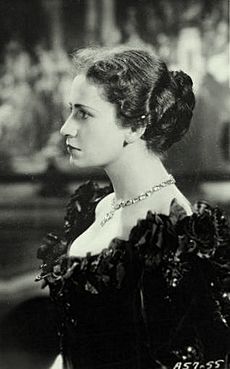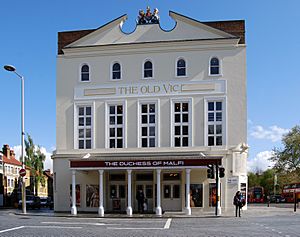Peggy Ashcroft facts for kids
Quick facts for kids
Peggy Ashcroft
|
|
|---|---|

Ashcroft in 1936
|
|
| Born |
Edith Margaret Emily Ashcroft
22 December 1907 Croydon, Surrey, England
|
| Died | 14 June 1991 (aged 83) |
| Spouse(s) |
Rupert Hart-Davis
(m. 1929; div. 1933)Theodore Komisarjevsky
(m. 1934; div. 1936)Jeremy Hutchinson
(m. 1940; div. 1965) |
Dame Edith Margaret Emily Ashcroft (22 December 1907 – 14 June 1991), known as Peggy Ashcroft, was a famous English actress. Her acting career lasted for over 60 years. She was known for her amazing performances on stage, especially in plays by William Shakespeare.
Peggy Ashcroft came from a comfortable family. From a young age, she knew she wanted to be an actress. She started working in small theatres even before finishing drama school. Within two years, she was a star in London's West End. She remained a leading actress in British theatre for the next 50 years. She loved working with permanent acting groups. She performed with the Old Vic, John Gielgud's companies, the Royal Shakespeare Company, and the National Theatre.
Besides Shakespeare, Ashcroft also loved modern plays. She acted in works by famous writers like Bertolt Brecht, Samuel Beckett, and Harold Pinter. For most of her career, she acted live on stage. In the 1980s, she started working in television and movies. She became very successful, winning two BAFTA awards and an Oscar.
Contents
Life and Career Highlights
Early Life and Training
Peggy Ashcroft was born in Croydon, England, on December 22, 1907. Her father was a land agent, and her mother was an amateur actress. Peggy's father died in the First World War. At school, one of her teachers encouraged her love for Shakespeare. However, her teachers and mother did not want her to become a professional actress.
But Peggy was determined. At 16, she joined the Central School of Speech and Drama. She learned a lot from reading My Life in Art by Constantin Stanislavski. He was a very important theatre director.
While still a student, Peggy made her first professional stage appearance. This was at the Birmingham Repertory Theatre. She acted opposite Ralph Richardson, another great actor. She finished drama school in 1927. She preferred working with smaller theatre groups to learn her craft. Her first big role in the West End was in Jew Süss in 1929. Critics praised her natural and truthful acting. That same year, she married Rupert Hart-Davis.
Becoming a Star in the 1930s
In 1930, Ashcroft played Desdemona in Othello at the Savoy Theatre. Paul Robeson played Othello. The play itself wasn't a huge hit, but Ashcroft's acting was excellent. She was surprised to receive hate mail for acting with a Black actor. This made her angry and aware of unfairness.
John Gielgud, a famous West End star, was very impressed by her. He said that when Peggy came on stage, "all the lights in the theatre had suddenly gone up." In 1932, Gielgud directed Romeo and Juliet. Ashcroft played Juliet, and Edith Evans played the Nurse. Both actresses received wonderful reviews.
Ashcroft joined the Old Vic theatre company for the 1932–33 season. The Old Vic was known for showing classic plays, especially Shakespeare, at low prices. Many famous actors took pay cuts to work there. It was a great place to learn Shakespearean acting. During this time, Ashcroft played five Shakespearean heroines. She also acted in her first film, The Wandering Jew, in 1933. She didn't love making movies and only made four more films over the next 25 years.
In 1934, she married Theodore Komisarjevsky, a director. He taught her the importance of being disciplined and aiming for perfection in acting.
After appearing in the Hitchcock film The 39 Steps (1935), Ashcroft played Juliet again. This time, it was in a very popular West End play directed by Gielgud. Her Romeos were played by Laurence Olivier and Gielgud himself. Critics loved Ashcroft's performance. In 1936, she played Nina in The Seagull. Even though her marriage to the director was ending, her acting was praised.
In 1937, Ashcroft returned to London for a season of plays with Gielgud's company. She played the Queen in Richard II, Irina in Three Sisters, and Portia in The Merchant of Venice. This group of actors helped set the stage for important theatre companies like the Royal Shakespeare Company.
Acting in the 1940s and 1950s
In 1940, Ashcroft married Jeremy Hutchinson, a lawyer. They had a daughter, Eliza, in 1941. During the war years, Ashcroft did less stage work. She mainly appeared in Gielgud's company in 1944. She played Ophelia in Hamlet and Titania in A Midsummer Night's Dream. After the war, she had a second child, Nicholas, in 1946.
She returned to the stage in 1947. She had two big successes in a row. She played Evelyn Holt in Edward, My Son and Catherine Sloper in The Heiress.
In the 1950s, Ashcroft returned to Shakespeare at the Shakespeare Memorial Theatre. She played Beatrice in Much Ado About Nothing with Gielgud. In 1951, she went back to the Old Vic. She played Viola in Twelfth Night and the main role in Electra. Critics said she reached "austere peaks of Greek tragedy" in Electra.
Throughout the rest of the 1950s, Ashcroft acted in both commercial plays and experimental works. She was praised for her roles in The Deep Blue Sea (1952) and The Chalk Garden (1956). She also played Hedda Gabler (1954) and a double role in The Good Woman of Setzuan (1956).
In 1958, Peter Hall asked Ashcroft to join his new company. This company would become the Royal Shakespeare Company (RSC). Ashcroft agreed right away, and her decision helped make the RSC a success.
The Royal Shakespeare Company and Later Stage Roles
In the first seasons of the RSC, Ashcroft played many important roles. These included Katharina in The Taming of the Shrew and Paulina in The Winter's Tale (1960). Her performance as Margaret of Anjou in The Wars of the Roses (1963-1964) was especially praised. She played the character from young adulthood to old age.
In the 1960s, Ashcroft took on many challenging roles. She played Arkadina in The Seagull (1964) and Mrs Alving in Ibsen's Ghosts (1967). She also acted in plays by Edward Albee and Harold Pinter.
Success in Film and Television
In the 1970s, Ashcroft continued to be a key actress for the RSC. She also performed at the National Theatre. In 1972, she surprised many by appearing in a comedy, Lloyd George Knew My Father. She showed unexpected depth in her character.
Her last stage role was the Countess in All's Well That Ends Well in 1981-1982.
Later in her career, Ashcroft had great success in television and film. For The Jewel in the Crown, she won a BAFTA award for best actress in 1984. For her role as Mrs. Moore in David Lean's 1984 film A Passage to India, she won another BAFTA and the 1985 Oscar for Best Supporting Actress. At 77 years old, she was the oldest person to win that Oscar at the time. Her final performance was in a radio play about India, In the Native State.
Peggy Ashcroft died in London at the age of 83. Her ashes were scattered in Stratford-upon-Avon, where she had planted a mulberry tree.
Awards and Recognition
Peggy Ashcroft received many honours and awards for her acting. She was made a Commander of the Order of the British Empire (CBE) in 1951. In 1956, she became a Dame Commander of the Order (DBE). This means she was given the title "Dame," similar to a knight.
She also received honorary degrees from eight universities. Besides her Oscar and BAFTA awards, she won a Laurence Olivier Award for Best Actress in 1976. She also received awards from the Venice Film Festival and special awards from BAFTA.
Peggy Ashcroft is remembered with a plaque in Poets' Corner, Westminster Abbey. The Ashcroft Theatre in Croydon is named in her honour. The Royal Shakespeare Company also has an Ashcroft Room named after her.
Images for kids
See also
 In Spanish: Peggy Ashcroft para niños
In Spanish: Peggy Ashcroft para niños








